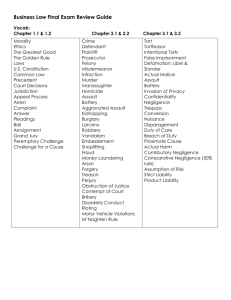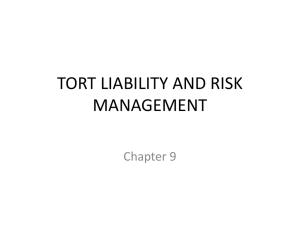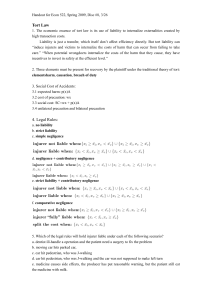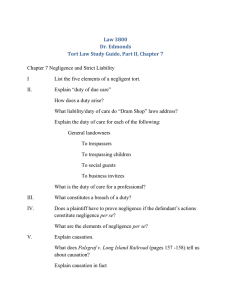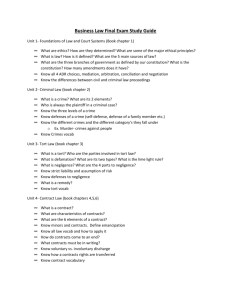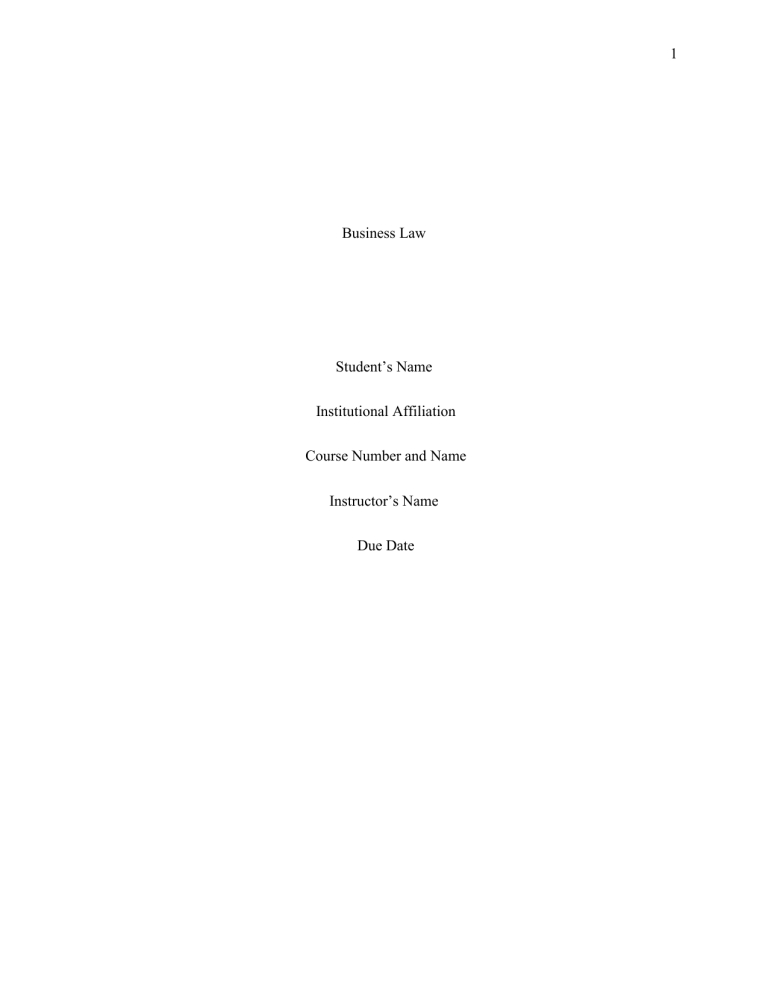
1 Business Law Student’s Name Institutional Affiliation Course Number and Name Instructor’s Name Due Date 2 Answer 1: In business law, a tort is a wrongful act that unfairly leads to harm or injury, which in turn causes a civil legal liability (Stoyanova, 2020). Essentially, a tort takes place when a person or a business organization wrongs someone, thus exposing them to a legal liability. The unlawful act does not always occur because the wrongdoer intentionally decides to harm or injure another person. Rather, a tort may occur if the wrongdoer acts negligently (Charnvitayapong, 2020). In Bantegro Food Company’s case, the tort of negligence provides Jon with the best possibility of successfully suing the company because it failed to act carefully enough, and as a result, he suffered serious injuries after striking a match box to light a cigar. The company operates a plant that processes and packages different foods, including meats and vegetables. In the course of doing so, it generates a large amount of waste product. The company has always buried the wasters in a ravine located in the boundaries of its compound, and although they knew that the wastes generated methane, they did nothing about it. Recently, an invisible cloud drifted from the ravine into the near residential district. As a result, Jon suffered terrible injuries after striking a match to light a cigar when the flame from the match ignited the cloud of gas and caused a fireball that engulfed him. Bantegro Food Company has a duty to ensure that the property is reasonably safe for those that enter it, their customers, and the surrounding society. However, the company neglected this duty by ignoring the drifting cloud of waste from the ravine into the surrounding environment. As a result, Jon, an innocent person standing on a public street in front of his house got injured. This level of negligence gives Jon the right to sue the company. 3 Answer 2: As a driver on the road, Michael had a duty of making sure that he took reasonable care to avoid causing other road users harm or injury. Therefore, admitting that he should have taken the keys with him confirms that he committed the tort of negligence. The teenagers who smashed Michael’s vehicle with a baseball bat were wrong for doing so, and he was justified to run after them. However, Michael neglected his duty to care for his fellow road users when he left the car keys in his car. According to Katsivela (2021), the general duty of care ensures that one conducts him or herself in a reasonable manner under any circumstances. In this case, any reasonable person would have locked the car and left with the keys to avoid theft. Therefore, Jeff is justified to sue Michael for negligence because had he acted like a reasonable person, his car would not have been stolen, and the thief would not have crushed Jeff’s truck with Michael’s car. Besides, Jeff was right to sue Michael because he incurred losses as a direct consequence of Michael’s negligence. Stoyanova (2020) asserts that the defendant is only responsible for another person’s harm or injury if their actions prove to be the most probable causes of the damage incurred. In this case, Jeff would not have incurred any damages had Michael’s vehicle not have rammed in his truck due to his negligence. Therefore, although Michael did not intend to cause harm to Jeff, his actions are still illegal because he let his carelessness damage Jeff’s car. Furthermore, Voyiakis (2018) claims that the plaintiff has to incur damages that can be resolved using monetary reimbursement. In this case, Michael should be sued for negligence because Jeff’s truck incurred damages that can only be compensated with money. 4 References Charnvitayapong, K. (2020). Biases in Tort Cases and Debiasing: Behavioral Economics Perspectives. วารสาร เศรษฐศาสตร์ และ กลยุทธ์ การ จัดการ (Journal of Economics and Management Strategy), 7(1), 173-194. Katsivela, M. (2021). The notion of causation and the tort of negligence (common law)/extracontractual personal liability (civil law) in Canada: A comparative legal study. COMPARATIVE LAW REVIEW, 10(1). Stoyanova, V. (2020). Common law tort of negligence as a tool for deconstructing positive obligations under the European convention on human rights. The International Journal of Human Rights, 24(5), 632-655. Voyiakis, E. (2018). Causation and opportunity in tort. Oxford Journal of Legal Studies, 38(1), 26-47. 5
